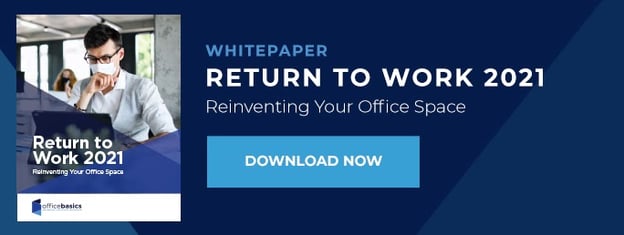
Did you know that half of all employees on the North American continent plan to look for another job in 2021? The Society for Human Resources Management (SHRM) is calling it a “turnover tsunami.”
Now that things are slowly returning to some semblance of normality, there are more jobs. This means employees no longer have to stay in a role because the economy is bad, which is one of the reasons companies are eager to implement effective employee engagement strategies.
What’s even more frightening is that top talent will probably be the first to go because it’s easier for them to find work. If the pandemic didn’t inspire you to put some serious focus on employee engagement and retention, it’s not too late.
We’ve outlined three strategies for not only bringing your employees back to the office but convincing them to stay.
3 Effective Employee Engagement Strategies
If you make a conscious effort to create a positive work environment for your employees, allow as much workplace flexibility as you can with your business model, and treat your employees as humans rather than “workers,” you can lower your turnover rate.
Take professional development seriously
It’s not enough to delegate and oversee the completion of tasks and projects. As a leader, professional development is part of your job.
This includes mentoring, training, connecting employees to resources to help them improve their jobs, and giving honest feedback on a regular basis.
Training and development help employees gain the knowledge and skills they need to advance. According to Indeed.com, the desire for job growth and career advancement is among the top 10 reasons employees leave.
Keep Your Eye on the Prize
Do you know the goals of your staff? When is the last time you discussed those short- and long-term goals in a 1-1 meeting? What are you doing to help them reach those goals? If the answer is nothing, you can guarantee that an ambitious employee will go elsewhere to achieve them.
Having short-term and long-term goals is motivating. Not unlike athletes who train harder when there’s an upcoming competition to prepare for, employees are likely to be more productive when they’re working toward a goal they care about.
Uncover Hidden Talents
A great best practice for mentoring employees is helping them discover their strengths through a well-researched tool such as Clifton Strengths and then ensuring their position and duties align with those strengths.
Unlike personality tests, which can feel, well, personal, this assessment looks at the 34 strengths that we all have to some degree and ranks them in the form of a detailed, personalized report.
The chances of two people sharing the top 5 strengths are 1 in 33 million.
Even if you aren’t ready to invest in standardized assessments, pay attention to the areas in which your employees excel and areas where they struggle.
When people are doing something they love, time stands still. Three hours can feel like 30 minutes.
They feel rejuvenated and look forward to more of that activity. New ideas keep coming to them even after they’ve switched to something else.
When they’re doing something they aren’t good at or that they just don’t care about, the opposite happens, leaving them feeling frustrated, drained, and looking for other jobs on the side.
The idea that work wouldn’t be called work if it were fun just isn’t true and won’t hold sway with today’s employees.
What are your employees passionate about outside of work? Is there a way to incorporate some of those passions at work? What do they hate doing? Is there someone else on the team who loves doing that same task?
Rather than force them to work on their “weaknesses,” partner them with people who excel in those areas. Not only will they enjoy their jobs, but they will feel seen and heard. You’re also setting them up for success, which is a win-win.
Develop and Promote a Healthy Office Environment
Let’s face it, if money talks, pay raises and bonuses can speak volumes about how your company values the employee and the position. But throwing money at people only goes so far, especially if you have a toxic work environment.
Find ways to support the needs, values and interests of your employees, such as a flexible schedule that allows them extra time in the morning to train for that Iron Man competition, a hybrid work schedule, or paid volunteer time to support their favorite charity.
Reward employees with a random day off for a good quarter or extra PTO that they can use whenever they want. Remember to recognize employees for exceptional work, whether it’s in the form of an award at a banquet, a certificate or simply a verbal thank you at an all-hands meeting.
Be transparent about the company’s values, goals, strengths and weaknesses and ask for feedback.
Warning: If you ask for feedback, be willing to do something about it. Employee surveys mean nothing if no one ever sees changes or if leadership becomes defensive.
Pay Attention to Office Aesthetics and Design

One of the many appealing characteristics of working remotely is the control employees have over their work environment.
They can work in multiple places in a day, depending on what will spark creativity or enable them to concentrate, such as their backyard, a hip coffee shop, a library, or simply a quiet room at home. The key is to provide these benefits, whenever possible, in your office space.
Outdoor Workspaces
An outdoor workspace is a great place for employees to collaborate while maintaining a safe social distance or find some inspiration when working alone. The fresh air, trees and flowers, and sounds of nature are relaxing, which is key to creativity and innovation.
Collaborative Spaces + Focus Areas
Bring the comforts of home to the office with collaborative office furniture that is comfortable and creates a more casual, relaxing atmosphere. This is the perfect setup for creative group brainstorming as opposed to formal meeting rooms where the energy feels more constricted.
Let in as much natural light as possible and incorporate plants throughout the office. An open office area allows more light and creates a sense of expansiveness and freedom.
Cubicles and offices created with transparent walls also allow light and a sense of openness while reducing noise and providing a germ barrier. Employees can choose to work here when focus, rather than collaboration, is the goal.
Breakroom
The most comfortable room in the house is often the kitchen, so stock up your breakroom with high-quality coffee, healthy snacks, and a large enough fridge for everyone to store their food.
Incorporate comfortable chairs and tables rather than the institutional ones that feel like a school cafeteria.
Be sure to follow these strategies for bringing back your breakroom safely.
The Easiest Strategy Is Also Free
Although the above tips are great examples of employee engagement strategies that work, it’s the daily interaction your employees have with each other, leadership, and your customers that matters most.
If their work environment and experiences are generally negative, a raise once a year or award every so often will mean very little.
Giving specific, genuine, positive feedback on a regular basis and promoting a healthy, caring work environment is what will keep your employees engaged and eager to come back to the office.
Best of all, it’s free!
Speaking of free, the team at Office Basics can help you design an office space that promotes employee engagement and the consultation won’t cost you a dime, so contact us today.




